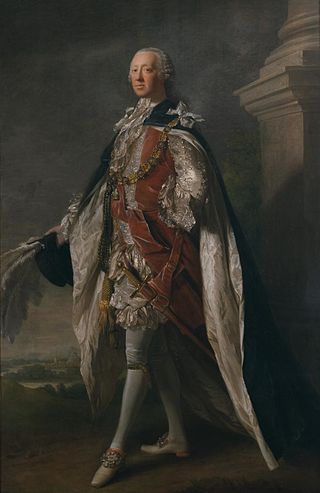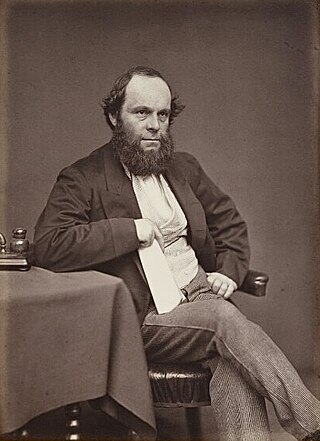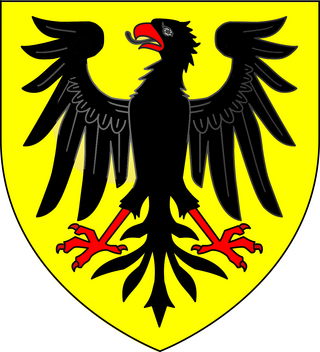
Lancelot Brown, more commonly known as Capability Brown, was an English gardener and landscape architect, who remains the most famous figure in the history of the English landscape garden style. He is remembered as "the last of the great English 18th-century artists to be accorded his due" and "England's greatest gardener".

George Grenville was a British Whig statesman who rose to the position of Prime Minister of Great Britain. Grenville was born into an influential political family and first entered Parliament in 1741 as an MP for Buckingham. He emerged as one of Cobham's Cubs, a group of young members of Parliament associated with Lord Cobham.

William Wyndham Grenville, 1st Baron Grenville, was a British Pittite Tory politician who served as Prime Minister of the United Kingdom from 1806 to 1807, but was a supporter of the Whigs for the duration of the Napoleonic Wars. As prime minister, his most significant achievement was the abolition of the slave trade in 1807. However, his government failed to either make peace with France or to accomplish Catholic emancipation and it was dismissed in the same year.

Richard Grenville-Temple, 2nd Earl Temple,, was a British politician. He is best known for his association with his brother-in-law William Pitt with whom he served in government during Britain's participation in the Seven Years War between 1756 and 1761. He resigned, along with Pitt, in protest at the cabinet's failure to declare war on Spain.

George Nugent-Temple-Grenville, 1st Marquess of Buckingham,, known as George Grenville before 1779 and as The Earl Temple between 1779 and 1784, was a British statesman.

Sir John Soane was an English architect who specialised in the Neo-Classical style. The son of a bricklayer, he rose to the top of his profession, becoming professor of architecture at the Royal Academy and an official architect to the Office of Works. He received a knighthood in 1831.
Hester Grenville, 1st Countess Temple, 2nd Viscountess Cobham was an English noblewoman. She was the mother and grandmother of the Prime Ministers George Grenville and William Grenville.

Stowe is a civil parish and former village about two miles northwest of Buckingham in the unitary authority area of Buckinghamshire, England. The parish includes the hamlets of Boycott, Dadford and Lamport.

Richard Temple, 1st Viscount Cobham was a British soldier and Whig politician. After serving as a junior officer under William III during the Williamite War in Ireland and during the Nine Years' War, he fought under John Churchill, 1st Duke of Marlborough, during the War of the Spanish Succession. During the War of the Quadruple Alliance Temple led a force of 4,000 troops on a raid on the Spanish coastline which captured Vigo and occupied it for ten days before withdrawing. In Parliament he generally supported the Whigs but fell out with Sir Robert Walpole in 1733. He was known for his ownership of and modifications to the estate at Stowe and for serving as a political mentor to the young William Pitt.

Wotton Underwood is a village and civil parish in Buckinghamshire, England, 7 miles (11 km) north of Thame, Oxfordshire.

Viscount Cobham is a title in the Peerage of Great Britain that was created in 1718. Owing to its special remainder, the title has passed through several families. Since 1889, it has been held by members of the Lyttelton family.
Captain William Winde (c.1645–1722) was an English gentleman architect, whose military career under Charles II, resulting in fortifications and topographical surveys but lack of preferment, and his later career, following the Glorious Revolution, as designer or simply "conductor" of the works of country houses, has been epitomised by Howard Colvin, who said that "Winde ranks with Hooke, May, Pratt and Talman as one of the principal English country house architects of the late seventeenth century".
The Baronetcy of Temple, of Stowe, in the Baronetage of England, was created on the 24th of September 1611 for Thomas Temple, eldest son of John Temple of Stowe, Buckinghamshire. His great-grandson Sir Richard, 4th Baronet, was created Baron Cobham on 19 October 1714, and Viscount Cobham and Baron Cobham on 23 May 1718, the latter with a special remainder, failing his male issue to his sisters and their heirs male. Upon his death on the 13th September 1749, the barony of 1714 became extinct. Both the viscountcy and barony of 1718 passed to his elder sister, and the baronetcy passed to his second cousin once removed William Temple, of Nash House, who became 5th Baronet. On the death of Sir William's nephew Sir Richard Temple, 7th Baronet, on 15 November 1786, the baronetcy became dormant.

Richard Plantagenet Campbell Temple-Nugent-Brydges-Chandos-Grenville, 3rd Duke of Buckingham and Chandos,, styled Earl Temple until 1839 and Marquess of Chandos from 1839 to 1861, was a British soldier, politician and administrator of the 19th century. He was a close friend and subordinate of Benjamin Disraeli and served as the secretary of state for the colonies from 1867 to 1868 and governor of Madras from 1875 to 1880.

Stowe House is a grade I listed country house in Stowe, Buckinghamshire, England. It is the home of the private Stowe School and is owned by the Stowe House Preservation Trust. Over the years, it has been restored and maintained as one of the finest country houses in the UK. Stowe House is regularly open to the public.

James Grenville, 1st Baron Glastonbury, PC of Butleigh Court, Somerset was a United Kingdom politician, who was a member of both houses of Parliament during his career.
Sir Richard Grenville was a British politician who sat in the House of Commons from 1715 to 1727. Part of the Grenville family that welded great influence during the eighteenth century his descendants have included three Prime Ministers.

Sir Richard Temple, 3rd Baronet, KB was an English politician who sat in the House of Commons at various times between 1654 and 1697.
Elizabeth Grenville was an English artist and writer. She was the wife of George Grenville, prime minister from 1763 to 1765; the daughter of Sir William Wyndham, a prominent Tory politician; and the mother of William Grenville, prime minister from 1806 to 1807.

Stowe Gardens, formerly Stowe Landscape Gardens, are extensive, Grade I listed gardens and parkland in Buckinghamshire, England. Largely created in the 18th century, the gardens at Stowe are arguably the most significant example of the English landscape garden. Designed by Charles Bridgeman, William Kent, and Capability Brown, the gardens changed from a baroque park to a natural landscape garden, commissioned by the estate's owners, in particular by Richard Temple, 1st Viscount Cobham, his nephew Richard Grenville-Temple, 2nd Earl Temple, and his nephew George Nugent-Temple-Grenville, 1st Marquess of Buckingham.

















